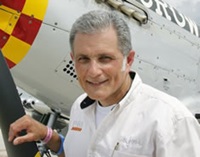

Warren Silberman
- Former Manager, FAA Aerospace Medical Certification
- Doctor of Osteopathic Medicine
- Expert in Aerospace/Preventive Medicine
- Pilot since 1986
Back to the present: When Snuffy arose from his chair he immediately passed out. Fortunately, one of his friends had watched him get up and start to go down, so he was able to break his fall, preventing him from hitting his head. They called an ambulance and Snuffy was taken to the local emergency room. One of his friends was a physician, but not an aviation medical examiner, and was familiar with the FAA medical standards. He told Snuffy he needed to report this to the Aerospace Medical Certification Division in Oklahoma City.
The doctors at the hospital gave Snuffy some IV fluids and he perked up and was able to get up without passing out. The laboratory tests showed that he had severe dehydration and in 24 hours he was discharged from the hospital. Unfortunately, the intern who wrote up his discharge gave him the diagnosis of syncope. Syncope means “passing out,” but doesn’t imply what caused the person to pass out. Snuffy recalled federal aviation regulation 61.53 that states that the airman should not fly if he/she develops a known medically disqualifying condition. Snuffy is an honest fellow and notified the medical certification division. When the FAA was notified, they denied his medical. The diagnosis of “a disturbance of consciousness without adequate explanation” happens to be one of the FAA's 15 specifically disqualifying medical conditions. If the airman cannot demonstrate a treatable known cause of this condition it results in a mandatory two-year disqualification.
Snuffy called AOPA's Pilot Protection Services. He had joined the program after speaking to the AOPA Medical Certification folks at EAA AirVenture in Oshkosh, Wis., that year. They had him send them his hospital medical records. This is where I came in.
I asked for the ambulance report, emergency room records, hospital history and physical examination, and discharge summaries. In those records I noted the history of the diarrheal illness and the abnormal laboratory results that supported the diagnosis. I wrote up a summary pointing these facts out and took the case to the FAA. They agreed with my opinion and granted recertification to Snuffy without the requirement for a special issuance.
The moral of the story is that in the case of any sort of “syncope," fainting, or passing out spell, the medical history is everything. The pilot should get an “eyewitness” if one is available, to provide his or her version of what occurred. In this case it saved Joe Snuffy from two years of watching his beautiful Tasmanian sit in the hangar.
To continue reading, please log in or join AOPA now to have access to these exclusive expert resources.
I am going to tell you the story of one of our members to make a point about a particular medical problem. As the once very popular TV show Dragnet would say, I've changed the name to protect the innocent. Joe Snuffy is a 60-year-old third-class airman who just so happens to be the owner of a P-51 Mustang with the name The Tasmanian. Snuffy was out at his hangar with the rest of his buddies one Saturday morning discussing the morning flight when he got up to go to the bathroom. A bit of history: Snuffy was quite ill the night before. He had been out of town at a meeting of his oil company held at a nationally known hotel. He had eaten lunch at the buffet that the hotel offers daily and flew home commercially. That night he awoke with severe abdominal cramps and spent the night having profuse diarrhea. He must have gone 10 times. His flying buddies did not know this.


